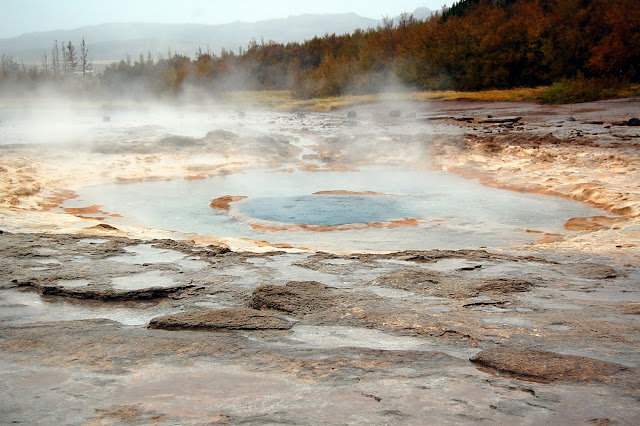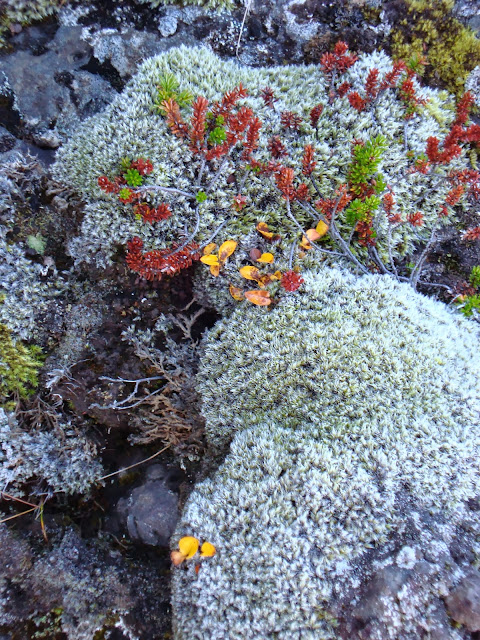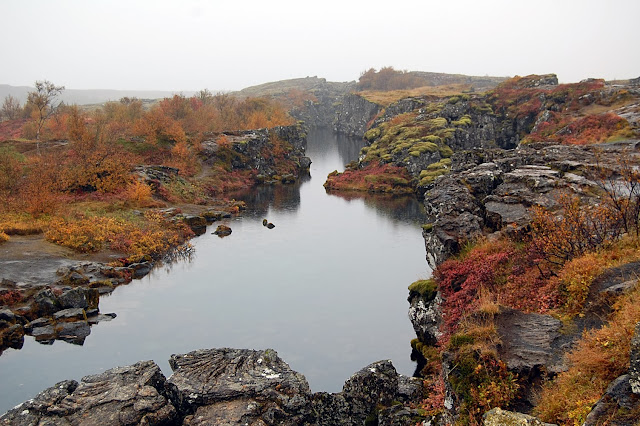Turf Houses
Early Icelandic settlers survived in houses insulated with turf. We saw three examples during our tour. In pouring rain at Skalholt we walked around this reconstructed specimen.
You can see rain drops in the next picture of the house's side and side door.
This particular house had small windows in front and rear.
The reconstructed turf farm house at Thjodveldisbaer, shown in the next images below, had no windows. It must have been dark and gloomy inside. The Thjodveldisbaer farm house is based on an actual ancient farm called Stong. The ancient Stong farm, along with 19 others, was buried under a blanket of pumice during the 1104 volcanic eruption of Mount Hekla. The Stong farm was particularly well preserved under the pumice, and this reconstruction is based on what was found during a successful 1939 excavation.
The house would normally have been closed at the time of our visit, but a film crew was shooting a documentary there, so we were allowed to see the interior. Below, a pot hangs above the fire pit in the long main hallway within the house.
Benches were arrayed on each side of the main hallway.
At the end of the hallway was a work room containing a loom.
Adjacent to the main farm house was a small turf church with a scenic waterfall behind it.
The next picture shows a portion of the vast pumice deposit that buried 20 farms in 1104.
Modern examples of turf houses were seen at Skogar. According to our guide, people lived without heat or electricity in houses like these in the late 1800's to early 1900's .
The next pictures show the spartan interior of these houses. Our guide said people slept five to a bed for warmth.
I can't imagine enduring such primitive conditions in this remote country.
Sunday, November 24, 2013
Saturday, November 16, 2013
Iceland - Part 5
Geothermal Fields
Iceland sits atop the Mid-Atlantic Ridge where the North American and European tectonic plates are separating. The Icelandic Rift Zone cuts diagonally through the country. In the picture below, taken on our first day in Iceland, the European plate is on the left and the North American plate is on the right.
Iceland has active volcanoes, and there are many hot spots not far below the surface. After seeing the fissure between tectonic plates pictured above, we visited a geothermal field near a geothermal power plant. We were warned not to venture too near scalding volcanic vents by signs like this.
Hot vapors and smelly sulfur fumes spewed from the ground.
This hole emitted a warning hiss. The ground around these vents had coloring reminiscent of Jupiter's volcanic moon, Io.
We also saw bubbling mud pots.
Here's a mosaic wide angle view of part of the geothermal field. Click on the image for a larger view.
A geothermal power plant can be seen in the center background of the previous picture with plumes of steam rising in the distance. Iceland gets approximately 26% of its energy from geothermal plants. The overwhelming majority of heating and hot water for buildings is supplied by geothermal sources. The remainder of Iceland's energy requirements are met almost entirely by hydroelectric plants. Iceland must have the greatest renewable energy infrastructure in the world! On our last day of touring we saw the geothermal power plant in the background of the previous picture from a different angle. This new view of the power plant is shown in the next picture. The plumes are steam, not polluting smoke.
Iceland is famous for its Blue Lagoon located near a different geothermal power plant. This is an outdoor spa where people soak in warm water no matter what weather exists. Click for a larger image.
C went in the Blue Lagoon, but I did not. Instead, I hung around to document her experience. Undressing, showering, stuffing a locker, getting soaked, and carting around the resulting wet bathing suit afterward just didn't appeal to me. C enjoyed cruising around the steamy lagoon and smearing white mud pack skin treatment on her face. You can see some of this white stuff on her forehead in the picture below.
Geysers are another phenomenon associated with geothermal fields. We visited the site of the Icelandic geyser, named Geysir, which gave its name to all other geysers. The boiling water hole pictured below bubbled vigorously while rain fell and foggy mist surrounded us.
The blue cauldron in the next picture is where the Strokkur geyser originates. It erupts 25 to 35 meters high about once every 8 to 10 minutes. We saw it erupt 4 or 5 times. It was quite a show!
Other pools of hot blue water were scattered about near the geysers.
Here is the famous prototype geyser, named Geysir. It doesn't erupt on a regular schedule, and didn't erupt while we were present. Apparently, it is active only after earthquakes.
After visiting the geysers we returned to our tour bus, damp, but happy.
Iceland sits atop the Mid-Atlantic Ridge where the North American and European tectonic plates are separating. The Icelandic Rift Zone cuts diagonally through the country. In the picture below, taken on our first day in Iceland, the European plate is on the left and the North American plate is on the right.
Iceland has active volcanoes, and there are many hot spots not far below the surface. After seeing the fissure between tectonic plates pictured above, we visited a geothermal field near a geothermal power plant. We were warned not to venture too near scalding volcanic vents by signs like this.
Hot vapors and smelly sulfur fumes spewed from the ground.
This hole emitted a warning hiss. The ground around these vents had coloring reminiscent of Jupiter's volcanic moon, Io.
We also saw bubbling mud pots.
Here's a mosaic wide angle view of part of the geothermal field. Click on the image for a larger view.
A geothermal power plant can be seen in the center background of the previous picture with plumes of steam rising in the distance. Iceland gets approximately 26% of its energy from geothermal plants. The overwhelming majority of heating and hot water for buildings is supplied by geothermal sources. The remainder of Iceland's energy requirements are met almost entirely by hydroelectric plants. Iceland must have the greatest renewable energy infrastructure in the world! On our last day of touring we saw the geothermal power plant in the background of the previous picture from a different angle. This new view of the power plant is shown in the next picture. The plumes are steam, not polluting smoke.
Iceland is famous for its Blue Lagoon located near a different geothermal power plant. This is an outdoor spa where people soak in warm water no matter what weather exists. Click for a larger image.
C went in the Blue Lagoon, but I did not. Instead, I hung around to document her experience. Undressing, showering, stuffing a locker, getting soaked, and carting around the resulting wet bathing suit afterward just didn't appeal to me. C enjoyed cruising around the steamy lagoon and smearing white mud pack skin treatment on her face. You can see some of this white stuff on her forehead in the picture below.
Geysers are another phenomenon associated with geothermal fields. We visited the site of the Icelandic geyser, named Geysir, which gave its name to all other geysers. The boiling water hole pictured below bubbled vigorously while rain fell and foggy mist surrounded us.
The blue cauldron in the next picture is where the Strokkur geyser originates. It erupts 25 to 35 meters high about once every 8 to 10 minutes. We saw it erupt 4 or 5 times. It was quite a show!
Other pools of hot blue water were scattered about near the geysers.
Here is the famous prototype geyser, named Geysir. It doesn't erupt on a regular schedule, and didn't erupt while we were present. Apparently, it is active only after earthquakes.
After visiting the geysers we returned to our tour bus, damp, but happy.
Friday, November 8, 2013
Iceland - Part 4
Mossy Landscape
Compared to countries in the temperate zone Iceland has few forests and hardly any big trees. Instead, Iceland has lots of moss and smaller plants clinging to life in this northern volcanic land. I'm no botanist, but I found the unfamiliar mossy landscapes intriguing. The next three pictures were taken by C on an old lava field.
Moss added color during our hike in the "Green Valley" in Landmannalaugar:
More moss softens volcanic terrain seen during C's hike through a rocky-bottomed valley in the Thorsmork Nature Reserve:
Aside from moss, other plants cling tenaciously to the otherwise barren volcanic land, like this grass growing in black volcanic soil near the coastline.
Or this small cluster of star-like sprouts growing in cracks between volcanic rocks.
Or this little green oasis sitting in a wet, sheltered spot among coastal rocks.
Autumn yellow and red were displayed within many fissures in Thingvellir National Park on a dim, rainy day.
Some grass and small berry-bearing plants were present in this sunny scene at Gluggafoss.
There are trees in Iceland, now carefully tended and preserved, even some evergreens seen in the background in Skogar.
There are lovely birch trees, though often stunted and small as in these pictures, also from Skogar.
On our last full day in Iceland we hiked in the Thorsmork Nature Reserve in a valley protected from harsh weather. Although this area is close to volcanoes and glaciers, it harbors a relatively rich collection of vegetation.
Much of Iceland is barren, nearly lifeless volcanic terrain, but there are also many rich pastures with lush grass for grazing sheep and horses.
Stay tuned for more Iceland pictures in my next post.
Compared to countries in the temperate zone Iceland has few forests and hardly any big trees. Instead, Iceland has lots of moss and smaller plants clinging to life in this northern volcanic land. I'm no botanist, but I found the unfamiliar mossy landscapes intriguing. The next three pictures were taken by C on an old lava field.
More moss softens volcanic terrain seen during C's hike through a rocky-bottomed valley in the Thorsmork Nature Reserve:
Aside from moss, other plants cling tenaciously to the otherwise barren volcanic land, like this grass growing in black volcanic soil near the coastline.
Or this small cluster of star-like sprouts growing in cracks between volcanic rocks.
Or this little green oasis sitting in a wet, sheltered spot among coastal rocks.
Autumn yellow and red were displayed within many fissures in Thingvellir National Park on a dim, rainy day.
Some grass and small berry-bearing plants were present in this sunny scene at Gluggafoss.
There are trees in Iceland, now carefully tended and preserved, even some evergreens seen in the background in Skogar.
There are lovely birch trees, though often stunted and small as in these pictures, also from Skogar.
On our last full day in Iceland we hiked in the Thorsmork Nature Reserve in a valley protected from harsh weather. Although this area is close to volcanoes and glaciers, it harbors a relatively rich collection of vegetation.
Much of Iceland is barren, nearly lifeless volcanic terrain, but there are also many rich pastures with lush grass for grazing sheep and horses.
Stay tuned for more Iceland pictures in my next post.
Subscribe to:
Posts (Atom)
People say I'm crazy doing what I'm doing
Well they give me all kinds of warnings to save me from ruin
When I say that I'm o.k. well they look at me kind of strange
Surely you're not happy now you no longer play the game
People say I'm lazy dreaming my life away
Well they give me all kinds of advice designed to enlighten me
When I tell them that I'm doing fine watching shadows on the wall
Don't you miss the big time boy you're no longer on the ball
I'm just sitting here watching the wheels go round and round
I really love to watch them roll
No longer riding on the merry-go-round
I just had to let it go
John Lennon




















































